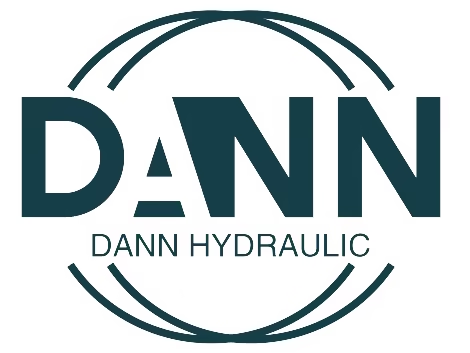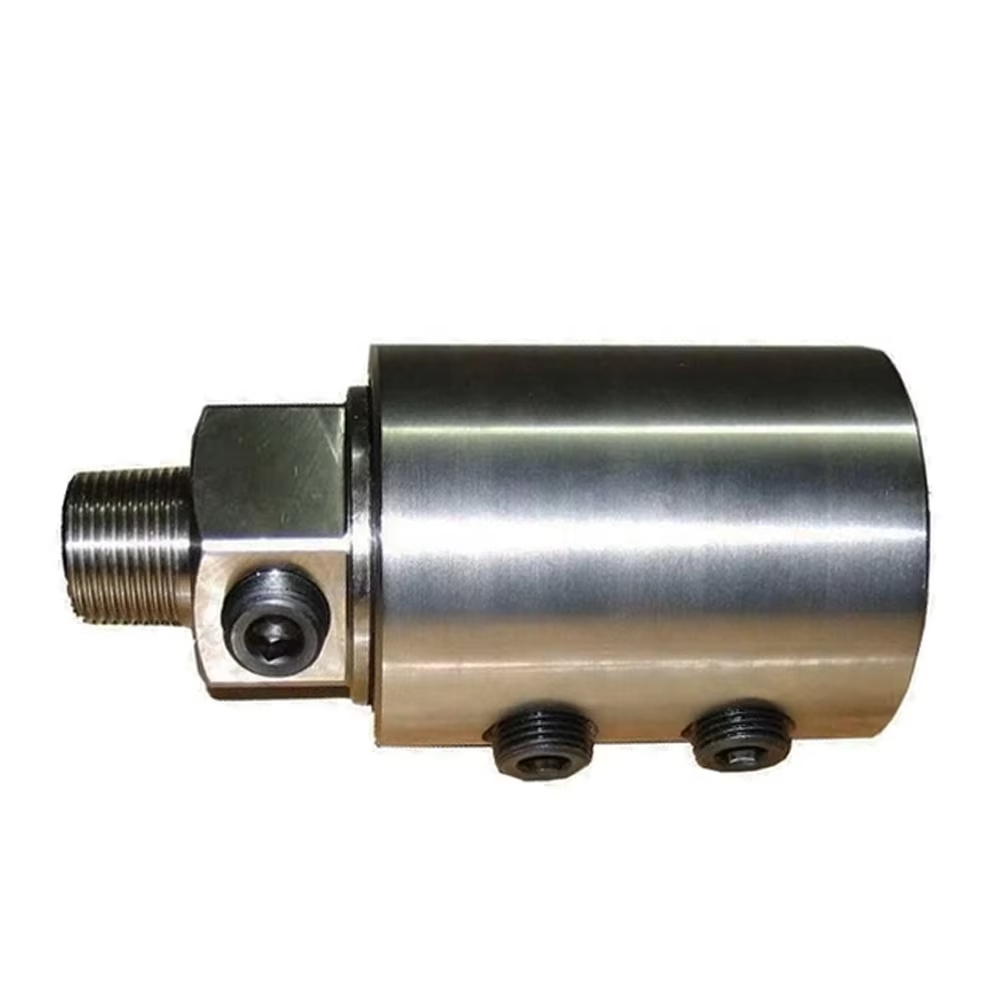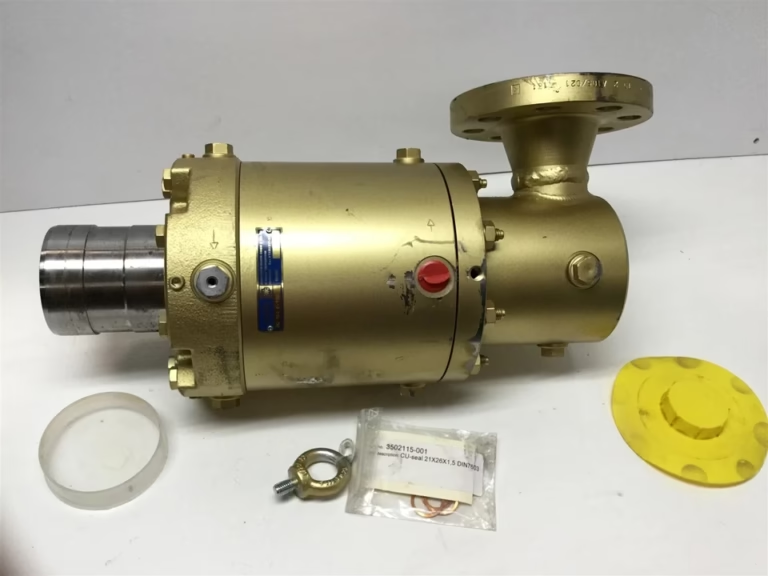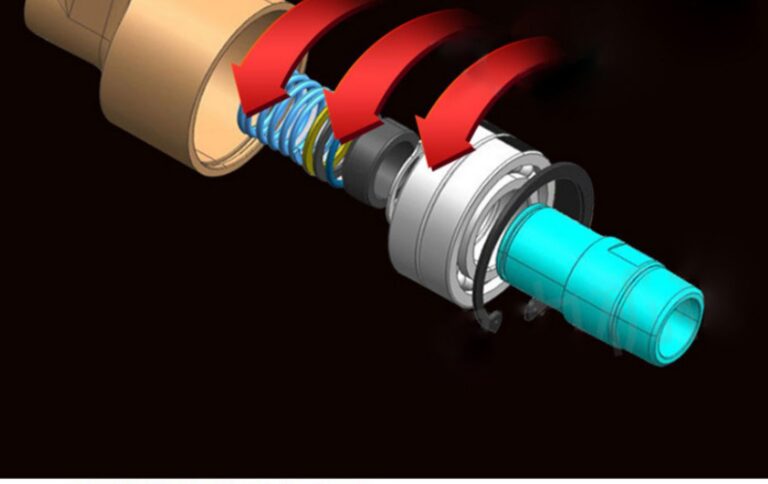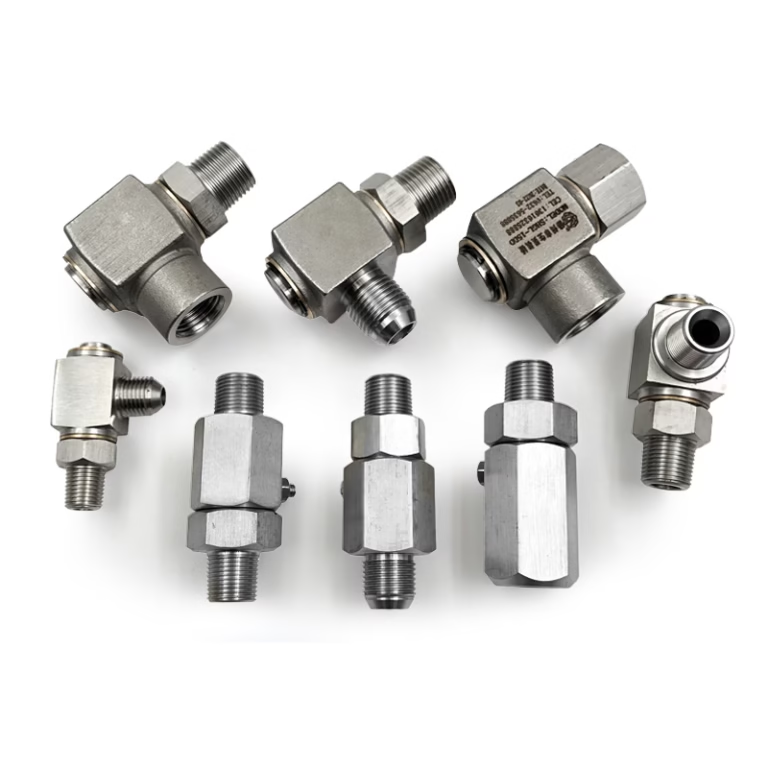Rotary joints for fluids, hydraulics & pneumatics
Introduction
In the intricate world of industrial machinery and engineering systems, rotary joints for fluids, hydraulics, and pneumatics are used. These small yet mighty components play a crucial role in ensuring the smooth operation of a wide range of equipment, from manufacturing plants to aerospace applications. In this blog post, we will dive deep into the realm of rotary joints, exploring their types, applications, benefits, and key considerations for selection and maintenance.
What are Rotary Joints?
At their core, rotary joints are mechanical devices that allow the transmission of fluids, gases, or power between stationary and rotating components. They consist of a rotating shaft or hub and a stationary housing, with seals and bearings to prevent leakage and ensure smooth rotation. Rotary joints can handle various media, including water, oil, air, steam, and chemicals, making them versatile components in many industries.
How Do Rotary Joints Work?
The principle is deceptively simple: balance pressure, speed, and friction. As the shaft spins, seals maintain contact with the housing to prevent media leakage. Bearings reduce friction, while internal channels direct fluids precisely where needed.
But wait—how do seals handle high speeds without wearing out?
Modern rotary joints use advanced materials like carbon graphite, ceramic composites, or engineered polymers. Some designs incorporate self-lubricating features, while others use air gaps or hydraulic balancing to minimize seal contact during rotation.
Types of Rotary Joints
Selecting the wrong joint type can lead to premature failure or inefficiency. Let’s break down the categories:
1. By Media Type
Fluid Rotary Joints
Fluid rotary joints are engineered to handle liquid-based media such as lubricating oils, cooling fluids, and water, ensuring leak-free transfer in dynamic systems. These joints often feature corrosion-resistant seals and precision bearings to withstand varying viscosities and temperatures. In machine tools, they facilitate continuous coolant delivery to cutting tools, enhancing efficiency and prolonging tool life. At steel mills, they manage high-temperature hydraulic oils in rolling mills, while chemical plants rely on them for transferring aggressive chemicals, requiring materials like stainless steel or PTFE to resist corrosion. Their design prioritizes compatibility with the fluid’s properties, making them critical for maintaining operational integrity in wet processing or heat-exchange applications.
Hydraulic Rotary Joints
Specialized for high-pressure hydraulic systems, these joints transmit hydraulic fluids (e.g., mineral oils, synthetic fluids) under pressures ranging from 1,000 to 10,000+ PSI. They incorporate robust components like forged steel housings and double-lip seals to prevent fluid loss and handle radial loads. In construction equipment, such as excavators or cranes, hydraulic rotary joints enable smooth rotation of the boom or turret while maintaining power transmission to actuators. In aerospace, they integrate into aircraft landing gear systems and engine fuel control units, ensuring reliable performance in extreme environments. Their ability to balance pressure, stability, and rotational speed makes them indispensable for heavy-duty machinery and precision aerospace applications alike.
Pneumatic Rotary Joints
Designed for gaseous media, pneumatic rotary joints transfer compressed air or inert gases (e.g., nitrogen) in low-pressure to medium-pressure systems (typically up to 300 PSI). They emphasize lightweight construction and minimal friction, often using polymer seals or magnetic coupling to achieve airtight connections. In robotics, these joints enable articulating arms to receive control signals and power via cables, supporting precise movements in assembly lines. Packaging machinery leverages them to operate pneumatic cylinders for tasks like filling, capping, or labeling, where a clean air supply is critical for food safety standards. Additionally, they appear in medical devices and semiconductor manufacturing, where contamination-free gas transfer and quiet operation are non-negotiable. Their versatility makes them essential for any system relying on gaseous power or control.
2. By Number of Passages
Single-Path Rotary Joints
Single-path rotary joints are the simplest type, designed to transmit a single fluid or gas through a single passage. They are commonly used in applications where a single medium needs to be transferred, such as cooling water systems, lubrication lines, or pneumatic controls. Single-path rotary joints can be further classified into axial and radial types, depending on the direction of fluid flow.
Multi-Path Rotary Joints
Multi-path rotary joints, as the name suggests, are capable of transmitting multiple fluids or gases simultaneously through separate passages. These joints are ideal for complex systems that require the transfer of multiple media, such as hydraulic systems with multiple lines, chemical processing plants, or food and beverage production facilities. Multi-path rotary joints can have two, three, or more passages, each with its own set of seals and connections.
3. By Design Complexity
High-Pressure Rotary Joints
High-pressure rotary joints are specifically designed to withstand high operating pressures, typically above 1000 psi (pounds per square inch). They are commonly used in hydraulic systems, oil and gas exploration, and industrial applications where high-pressure fluid transfer is required. High-pressure rotary joints feature robust construction, reinforced seals, and heavy-duty bearings to ensure reliable performance under extreme conditions.
High-Speed Rotary Joints
High-speed rotary joints are engineered to operate at high rotational speeds, often exceeding 10,000 RPM (revolutions per minute). They are commonly used in applications such as machine tools, printing presses, and centrifuges, where high-speed rotation is essential. High-speed rotary joints require precision manufacturing, advanced sealing technologies, and low-friction bearings to minimize heat generation and ensure smooth operation at high speeds.
Applications of Rotary Joints
Fluid Transfer
One of the primary applications of rotary joints is fluid transfer. Whether it’s water, oil, coolant, or chemicals, rotary joints enable the continuous flow of fluids between stationary and rotating components. In manufacturing plants, rotary joints are used in conveyor systems, mixing equipment, and machine tools to transfer fluids for cooling, lubrication, and processing. In the automotive industry, rotary joints are used in power steering systems, braking systems, and engine cooling systems.
Hydraulic Systems
Hydraulic systems rely on the transmission of hydraulic fluid under high pressure to generate force and motion. Rotary joints play a crucial role in hydraulic systems by allowing the transfer of hydraulic fluid between stationary and rotating components, such as cylinders, motors, and pumps. Without rotary joints, hydraulic systems would not be able to operate efficiently, as the fluid would leak or be unable to reach the necessary components. In construction equipment, agricultural machinery, and industrial robots, rotary joints are essential for the smooth operation of hydraulic systems.
Pneumatic Systems
Pneumatic systems use compressed air to power various devices and machinery. Rotary joints are used in pneumatic systems to transfer compressed air between stationary and rotating components, such as air cylinders, valves, and actuators. In the food and beverage industry, rotary joints are used in packaging machines to control the flow of air for filling, sealing, and labeling. In the pharmaceutical industry, rotary joints are used in tablet presses and other equipment to ensure the precise delivery of compressed air for process control.
Aerospace Applications
In the aerospace industry, rotary joints are used in a wide range of applications, from aircraft engines to landing gear systems. Rotary joints are essential for the transfer of fuel, oil, air, and hydraulic fluid between stationary and rotating components in aircraft engines, ensuring the smooth operation and efficiency of the engines. In landing gear systems, rotary joints are used to transfer power and control signals between the aircraft’s body and the landing gear, allowing for the extension and retraction of the landing gear.
Benefits of Rotary Joints
Improved Efficiency
By enabling the seamless transfer of fluids, hydraulics, and pneumatics between stationary and rotating components, rotary joints help improve the efficiency of industrial machinery and engineering systems. They reduce the need for complex plumbing and hosing, minimize fluid leakage, and ensure smooth operation, resulting in increased productivity and reduced downtime.
Enhanced Reliability
Rotary joints are designed to withstand harsh operating conditions, including high temperatures, pressures, and speeds. They are constructed from durable materials and feature advanced sealing technologies and bearings to ensure long-term reliability and performance. By using high-quality rotary joints, industries can minimize the risk of equipment failure, reduce maintenance costs, and improve overall system reliability.
Increased Flexibility
Rotary joints offer increased flexibility in the design and operation of industrial machinery and engineering systems. They allow for the rotation of components without the need for complex and bulky connections, enabling the creation of more compact and efficient designs. Additionally, rotary joints can be easily integrated into existing systems, making it easier to upgrade or modify equipment as needed.
Cost Savings
While rotary joints may require an initial investment, they can result in significant cost savings in the long run. By improving the efficiency and reliability of industrial machinery and engineering systems, rotary joints can reduce energy consumption, minimize maintenance costs, and extend the lifespan of equipment. Additionally, the use of rotary joints can help prevent costly fluid leaks and spills, which can have environmental and safety implications.
Key Considerations for Selection and Maintenance
Selection Criteria
When selecting a rotary joint for a specific application, several factors need to be considered, including the type of fluid or gas being transferred, the operating pressure and temperature, the rotational speed, the required flow rate, and the environmental conditions. It is important to choose a rotary joint that is compatible with the specific requirements of the application to ensure optimal performance and reliability.
Critical Factors for Selecting Rotary Joints
Choosing a joint isn’t just about specs—it’s about matching performance to your application’s demands.
1. Operating Parameters
Pressure: Hydraulic systems may require 5,000+ PSI ratings.
Temperature: Some joints withstand -40°C to 400°C (e.g., in furnaces).
Speed: High-RPM applications need specialized bearings and seals.
2. Media Compatibility
Aggressive chemicals demand corrosion-resistant materials (e.g., Hastelloy®, 316L stainless steel). Food-grade joints use FDA-approved elastomers.
3. Maintenance Requirements
Self-Lubricating Designs: Reduce downtime in remote locations (offshore platforms).
Modular Construction: Allows quick seal replacement without disassembling the entire joint.
4. Cost vs. Lifespan
A 2,000 joint lasting 5 years may be cheaper than a 1,000 joint failing annually when considering labor and replacement parts.
Maintenance Tips
Regular maintenance is essential for the proper functioning and longevity of rotary joints. Some key maintenance tips include inspecting the joints for leaks, wear, and damage regularly, lubricating the bearings and seals as recommended by the manufacturer, and replacing worn or damaged components promptly. Additionally, it is important to follow the manufacturer’s installation and operating instructions to ensure the safe and efficient operation of the rotary joints.
The Future of Rotary Joints: Smart & Sustainable
Industry 4.0 is transforming these components:
1. IoT Integration
Sensors now monitor temperature, vibration, and leak rates in real-time. Predictive maintenance algorithms alert teams before failures occur.
2. Additive Manufacturing
3D-printed titanium joints reduce weight by 40% for aerospace applications.
3. Eco-Friendly Designs
Dry-Running Seals:
Eliminate lubricant contamination risks.
Energy Recovery Systems:
Some joints capture hydraulic energy to power auxiliary systems.
Installation Best Practices
Even a perfect joint will fail if installed poorly. Follow these steps:
Align Shafts:
Misalignment as small as 0.1mm can cut seal life by 50%.
Use Torque Wrenches:
Over-tightening bolts distorts the housing and causes leaks.
Pre-Lube Seals:
Apply a thin film of compatible grease before startup.
Run-In Period:
Operate at 50% load for the first 24 hours to seat seals.
Case Study:
Saving $1.2M/Year in a Steel Mill
A Midwestern steel plant faced recurring failures in its continuous caster rotary joints. Leakage caused 12 unplanned stops monthly. After switching to ceramic-sealed joints with IoT monitoring:
Downtime reduced by 83%
Annual maintenance costs dropped from 480kto120k
Energy savings from optimized cooling added $60k/year
Total savings: $1.2M annually
FAQ:
How do I select the right rotary joint for my application?
A: Prioritize factors like media type (fluid/hydraulic/pneumatic), pressure rating (e.g., high-pressure for hydraulic systems), temperature, rotational speed, and environment (e.g., choose corrosion-resistant materials for aggressive fluids). Match port sizes and system compatibility.
What is the typical maintenance schedule for rotary joints?
A: Conduct quarterly inspections for seal wear, loose connections, and leaks. Lubricate bearings monthly per the manufacturer’s guidelines; reduce intervals to weekly/biweekly in high-load scenarios. Address unusual vibrations or noises immediately.
What are the common causes of rotary joint leaks?
A: Leaks often stem from seal degradation, misalignment during installation, media contaminants causing abrasion, or pressure overload. Prevent issues by replacing seals regularly, ensuring coaxial alignment, installing filters, and monitoring operational parameters.
Conclusion
Rotary joints are essential components in industrial machinery and engineering systems, facilitating the seamless transfer of fluids, hydraulics, and pneumatics between stationary and rotating components. By understanding the different types of rotary joints, their applications, benefits, and key considerations for selection and maintenance, industries can make informed decisions when choosing and using rotary joints in their systems. Whether it’s improving efficiency, enhancing reliability, increasing flexibility, or saving costs, rotary joints play a crucial role in the smooth operation and success of industrial processes. So, the next time you see a piece of industrial machinery in action, take a moment to appreciate the wonders of rotary joints and the vital role they play.
